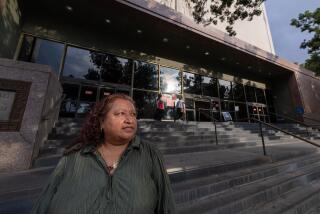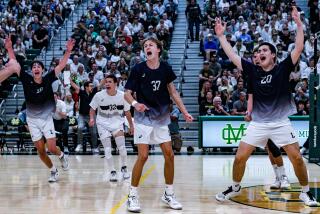Future Lawyers Get a High-Tech Education
- Share via
The videotape catches the two would-be lawyers scratching their heads as they interview a client. They mutter “um” and “like” probably a little more than they had ever noticed before. One tosses in the word “tort.”
“What’s a tort?” the client demands.
Challenged to describe the basic idea of a legal wrong, the students freeze. Their classmates erupt in laughter.
The students attend Loyola Law School. The “client” is actually a hired actor. On just about any school day, instant replay-style videos allow students to test their lawyering skills before actors who pose as clients and judges.
“Be prepared to explain every legal concept,” professor Arnold Seigal warns the two students.
So-called SmartVideo technology, which is easier to edit and maneuver than standard VHS video, is not new to law schools. But since its introduction to legal education, the role-playing possibilities have made the technology increasingly important at law schools across the country.
At Loyola, cutting-edge equipment in nearly every classroom is just one sign of the school’s growing sophistication in -- and enthusiasm for -- what’s known as trial advocacy. Trial advocacy programs teach students the nuts and bolts of litigation skills: how to successfully and ethically advocate their cases before judges, juries, the media and one another.
The urban campus in Pico Union, the school that taught such well-known lawyers as Robert Shapiro and Johnnie L. Cochran Jr., recently opened the multimillion-dollar Albert H. Girardi Advocacy Center, a state-of-the-art building designed by internationally acclaimed architect Frank O. Gehry.
The distinctive square, red structure features a trial courtroom, an appellate courtroom, a jury deliberation room, several classrooms and video training labs and a who’s who gallery of famous alumni and donors. U.S. Supreme Court Justice Anthony M. Kennedy attended opening ceremonies last month.
The center’s courtrooms, said director and professor Laurie Levenson, are expected to host real trials on a regular basis, and there are plans to get some of the biggest names in law to take up litigator-in-residence posts -- among them “the tobacco lawyers, the asbestos lawyers, the Enron lawyers,” she said. “Whoever’s hot, we will be inviting. And if it were an impeachment year, the impeachment lawyers.”
In two courtrooms, the judge sits at a bench equipped with touch-screen panels that make it easy to switch among live feed, video evidence and electronic graphs -- no more easels, markers and butcher paper.
There are video-monitored “interview” rooms where students meet “clients,” who are sometimes intentionally difficult, even confrontational. Sometimes they simply refuse to cooperate. In another room, fellow students can watch and critique. And after filming, students watch themselves, like football players studying pass techniques.
“Students can’t be afraid of technology,” Levenson said. “For all the judges that complain about cameras in the courtroom, we think it’s helpful.... There’s no better way to learn than to see yourself.”
Just a month old, the Girardi center is already turning heads.
“This is an expensive way to teach law students. There is lots of technology, computer graphics, hardware and software; rooms themselves have to be set up in a way that is not traditionally classroom-ish,” said University of Miami law professor Lawrence Rose, who also is executive director of the National Institute for Trial Advocacy.
“To see schools like Loyola produce centers like this, frankly, is very progressive, and very enlightening,” Rose said.
Loyola has for years produced videos teaching litigation skills that have been widely used by law schools and bar associations. The school’s central metropolitan location means a large proportion of its students end up working at Los Angeles’ downtown law firms.
Rose and others said that there’s more than high-tech legal learning aids in the school’s approach to teaching law.
As law schools across the country devote considerable resources to attract top students and professors, Loyola’s strategy is taking learning back to what professors say students take most for granted.
“A lot of law students think they’re just naturals when it comes to dealing with people. The truth is that law students until now have been woefully unprepared” for litigation, said Levenson, a former federal trial attorney. “I think we’ve learned that book learning is not good enough. There’s just been a disconnect between what’s learned in the classroom and what’s needed in the real world.”
Loyola students must “have one foot inside the ivy walls and one foot inside the practice of law,” she said.
In recent years, more and more Southern California law schools have bolstered their offerings in trial advocacy.
In December, Southwestern University School of Law in Los Angeles announced that it had acquired $1 million in federal money to help build its own teaching courtroom and trial advocacy center.
Professors at other Southland law schools said their curricula also have changed to reflect the growing interest in litigation skills. USC’s law school has added more litigation courses and has developed clinics that heavily rely on advocacy training, said professor and associate dean Scott Altman.
Though UCLA’s law school also has boosted its already strong trial advocacy offerings, professor Paul Bergman, who has written two books on the subject, said the school is not “rushing” to make trial advocacy its curricular crown jewel.
“The way we think about it is to continue to develop the theory and learning about trial advocacy, rather than to put money into buildings and flashy courtrooms,” he said.
Trial advocacy has caught on. National mock trial competitions draw student teams, usually coached by trial advocacy professors, from all corners of the country. Teams from Loyola brought home two national championships in 2001.
Gloria Allred, a prominent lawyer and radio show host, said the trial advocacy training she got at Loyola before she graduated in 1974 helped her forge relationships with district attorney litigators and even her future partners. Now, she said, what Loyola has to offer is several times more sophisticated, and Los Angeles’ future lawyers -- and clients -- stand to benefit.
“The challenge of the advocacy center will help toughen up the students and let them know what they can do, what’s expected of them,” she said. “Some of them have doubts, and the only way to resolve those doubts is to get in there and do it.”
More to Read
Sign up for Essential California
The most important California stories and recommendations in your inbox every morning.
You may occasionally receive promotional content from the Los Angeles Times.










